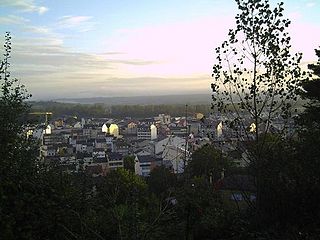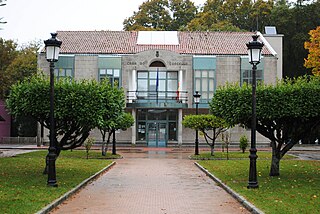
Galicia is an autonomous community of Spain and historic nationality under Spanish law. Located in the northwest Iberian Peninsula, it includes the provinces of A Coruña, Lugo, Ourense, and Pontevedra.

A Coruña is a city and municipality in Galicia, Spain. It is Galicia's second largest city, behind Vigo. The city is the provincial capital of the province of A Coruña, having also served as political capital of the Kingdom of Galicia from the 16th to the 19th centuries, and as a regional administrative centre between 1833 and 1982.

Lugo is a city in northwestern Spain in the autonomous community of Galicia. It is the capital of the province of Lugo. The municipality had a population of 98,025 in 2018, making it the fourth most populous city in Galicia.

Tui is a municipality in the province of Pontevedra, in the autonomous community of Galicia, Spain. It is located in the comarca of O Baixo Miño on the right bank of the Miño River, facing the Portuguese town of Valença. The municipality of Tui is composed of 11 parishes: Randufe, Malvas, Pexegueiro, Areas, Pazos de Reis, Rebordáns, Ribadelouro, Guillarei, Paramos, Baldráns and Caldelas.

Mondoñedo is a small town and municipality in the Galician province of Lugo, Spain. As of 2009, the town has a population of 4,508. Mondoñedo occupies a sheltered valley among the northern outliers of the Cantabrian Mountains. Despite being the core of the region of A Mariña Central, it is the city with the fifth biggest population after Viveiro, Ribadeo, Foz and Burela.

Monforte de Lemos is a town and municipality in northwestern Spain, in the province of Lugo, Galicia. It covers an area of 200 km2 and lies 62 km from Lugo. As of 2017 it had a population of 18,783.

The Kingdom of Galicia was a political entity located in southwestern Europe, which at its territorial zenith occupied the entire northwest of the Iberian Peninsula. It was founded by the Suebic king Hermeric in 409, with its capital established in Braga. It was the first kingdom that officially adopted Catholicism. In 449, it minted its own currency. In 585, it became a part of the Visigothic Kingdom. In the 8th century, Galicia became a part of the newly founded Christian Kingdom of Asturias, which later became the Kingdom of León, while occasionally achieving independence under the authority of its own kings. Compostela became the capital of Galicia in the 11th century, while the independence of Portugal (1128) determined its southern boundary. The accession of Castilian King Ferdinand III to the Leonese kingdom in 1230 brought Galicia under the control of the Crown of Castile.

Sarria is a municipality in the province of Lugo, in the autonomous community of Galicia, northwestern Spain. It belongs to the comarca of Sarria. Sarria is the most populous town on the French Way in Galicia, with 13,700 inhabitants and the major is Carmen José Lòpez. It is head of the region and the most popular starting point for the Camino de Santiago; many pilgrims choose Sarria because the distance from this point to Santiago allows them to cover the necessary kilometers to reach the Compostela. King Alfonso IX of León died in Sarria in 1230 while making a pilgrimage to Santiago de Compostela.

Boimorto is a municipality in the province of A Coruña, in the autonomous community of Galicia, northwestern Spain. It is located in the comarca of Arzúa. It has an area of 82.71 km2, a population of 2,486, and a population density of 30.06 people/km2. Coordinates: 43° 00' 27" N - 8° 07' 37" W. Elevation: 487 m.

Carballo is a municipality in the province of A Coruña, in the autonomous community of Galicia, in northwestern Spain. The town is the thirteenth most populated municipality in the region and it belongs to the comarca of Bergantiños, serving as its capital.

Chantada, is a municipality in the province of Lugo, Galicia, Spain.

Friol is a municipality in the Lugo province in Galicia. It is located in northwest Spain. It is bordered on the north by Begonte and Guitiriz, to the south by Palas de Rei and Guntín, to the east by Lugo and Outeiro de Rei and to the west by the province of La Coruña. It has an area of 292.29 km2. It has a population of 3,616 inhabitants according to the INE in 2024. The population density is 12 inhabitants/km2.

The Autovía A-54 is a freeway in Spain. It connects Santiago de Compostela with its airport with junctions onto the N-550, N-634 and Lugo via N-547.

O Saviñao is a Concello (council) in the province of Lugo, Galicia belonging to the district of Terra de Lemos. The main town for the council is Escairón.

Pedrafita do Cebreiro is a municipality in the province of Lugo in Galicia, Spain. It borders the Lugo municipalities of As Nogais, Cervantes, Folgoso do Courel, Samos and Triacastela. Its eastern boundary borders the province of León. It belongs to the comarca of Os Ancares.

The Pontevedra Museum is a museum in the Galician city of Pontevedra in Spain. It was founded by the Provincial Deputation of Pontevedra on 30 December 1927 and has six buildings for its exhibitions. It has permanent and temporary exhibition rooms. The museum's collections are multidisciplinary, classified into rooms for painting, sculpture, archaeology, decorative arts, engraving and ethnography.

The Pazo de García Flórez is an 18th-century baroque pazo located between Sarmiento Street and Plaza de la Leña in the city of Pontevedra, Spain, in the heart of the old town.

The Plaza de Teucro is a square of medieval origin located in the heart of the old town of Pontevedra (Spain). It is the most harmoniously proportioned medieval square in the city.

The historic centre of Pontevedra (Spain) is the oldest part of the city. It is the second most important old town in Galicia after Santiago de Compostela, and was declared a historic-artistic complex on 23 February 1951.

Calle Real is a street in the Spanish city of Pontevedra, located in the city's historic centre.























